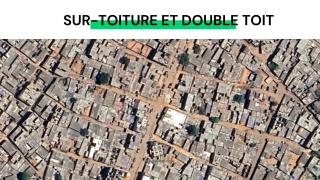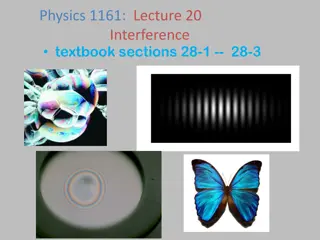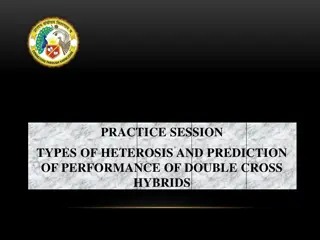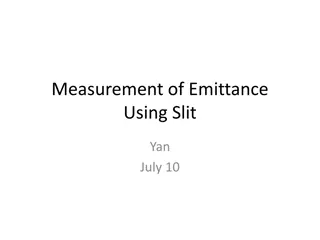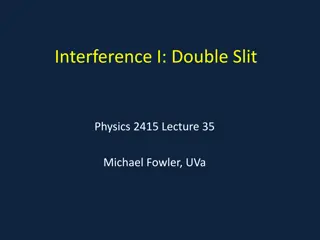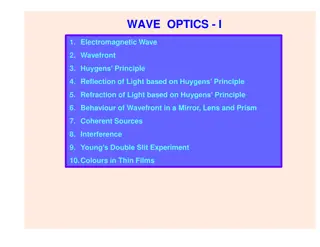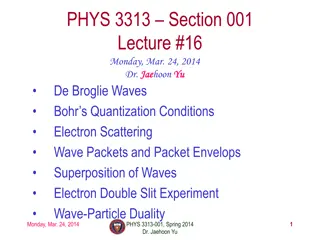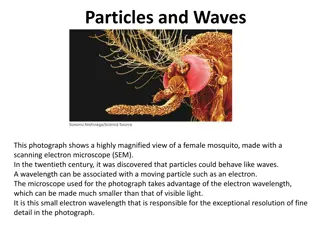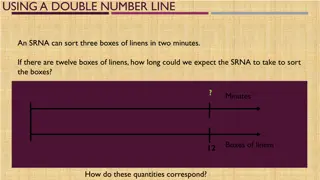Young’s double slit
Explore various examples and whiteboard problems related to Young's double slit experiment, diffraction patterns, and interference of light waves. From calculating fringe distances to determining wavelengths and frequencies of light, these examples provide a comprehensive overview of optical phenomena. Discover insights into slit separations, angular widths, and bright fringe distances on screens located at different distances from the slits.
Download Presentation

Please find below an Image/Link to download the presentation.
The content on the website is provided AS IS for your information and personal use only. It may not be sold, licensed, or shared on other websites without obtaining consent from the author.If you encounter any issues during the download, it is possible that the publisher has removed the file from their server.
You are allowed to download the files provided on this website for personal or commercial use, subject to the condition that they are used lawfully. All files are the property of their respective owners.
The content on the website is provided AS IS for your information and personal use only. It may not be sold, licensed, or shared on other websites without obtaining consent from the author.
E N D
Presentation Transcript
Example 1: A Parallel beam of light from a laser with a wavelength of 638 nm falls on two very narrow slits 0.0550 mm apart. A. How far apart are the fringes on the center of a screen 4.30 m away? B. What angle separates the central fringe, and the fifth order fringe? What distance is this on the screen? C. What distance separates the central fringe and the and the first minimum (destructive) location? 0.0499 m apart, 3.33o, 0.250 m, 0.0249 m
Example 2: The third order fringe of 620. nm light is observed at an angle of 21.0o when the light falls on two narrow slits. A. What distance separates the slits? B. What angle does the second order fringe make with the central fringe? What distance separates the central bright spot and the second order fringe on a screen 5.00 m away? d = 5.19x10-6 m, 13.8o, 1.23 m
Whiteboard 1: Monochromatic light falls on two very narrow slits 0.0450 mm apart. Successive fringes on a screen 6.00 m away are 7.20 cm apart. Determine the wavelength and the frequency of the light. 5.40x10-7 m, 540 nm
Whiteboard 2: Two narrow slits are separated by 1.00 mm are illuminated by 544 nm light. Find the distance between adjacent bright fringes on a screen 3.40 m away. What angle separates the central bright spot and the 4th order fringe? 0.00185 m (1.85 mm) apart, 0.00740 m (7.40 mm)
Minima: Dsin = n n = 1, 2, 3, (not 0)
Example: If 644 nm light falls on a slit 0.0560 mm wide, A. What is the full angular width of the central diffraction peak? B. What is its width on a screen that is 4.50 m away? C. What distance separates the central maximum from the third minimum on the screen 4.50 m away? 1.32o, 10.4 cm wide, 15.5 cm
Whiteboard 1: Monochromatic light falls on a slit that is 0.00320 mm wide. The angle between the central maximum and the second dark fringe on one side is 18.0o. What is the wavelength of light used? 4.94x10-7 m (494 nm)
Whiteboard 2: When blue light of wavelength 462 nm falls on a single slit, the first dark bands on either side are separated by 43.0o. Determine the width of the slit. 1.26x10-6 m (1.26 m)
Maxima: dsin = n n = 0, 1, 2, 3
Example 1: At what angle will 719 nm light produce a second order maximum when falling on a grating whose slits are 1.24x10-3 cm apart? B. What distance is this maximum from the center on a screen that is 4.30 m away? Maxima: dsin = n n = 0, 1, 2, 3 6.66o , 0.502 m from the center
Example 2: A 3600-line/cm grating produces a third order fringe at 23.0o. A. What is the wavelength of the light? B. How many orders are possible with this wavelength? Maxima: dsin = n n = 0, 1, 2, 3 362 nm, 7 is the max
Whiteboard 1: A diffraction grating produces a third order spectral line at 19.0o for 632.8 nm light. A. What is the distance between the slits or lines? B. How many lines are there per cm? Maxima: dsin = n n = 0, 1, 2, 3 5.83x10-6 m, 1714 lines per cm
Whiteboard 2: White light containing wavelengths from 410. nm to 750. nm falls on a grating with 8600 lines/cm. What distance separates the first order of the red end of the spectrum from the blue end on a screen that is 2.50 m away? Maxima: dsin = n n = 0, 1, 2, 3 410 nm: 20.646o, 0.942 m, 750 nm: 40.166o, 2.11 m, So the y would be 1.17 m apart.



